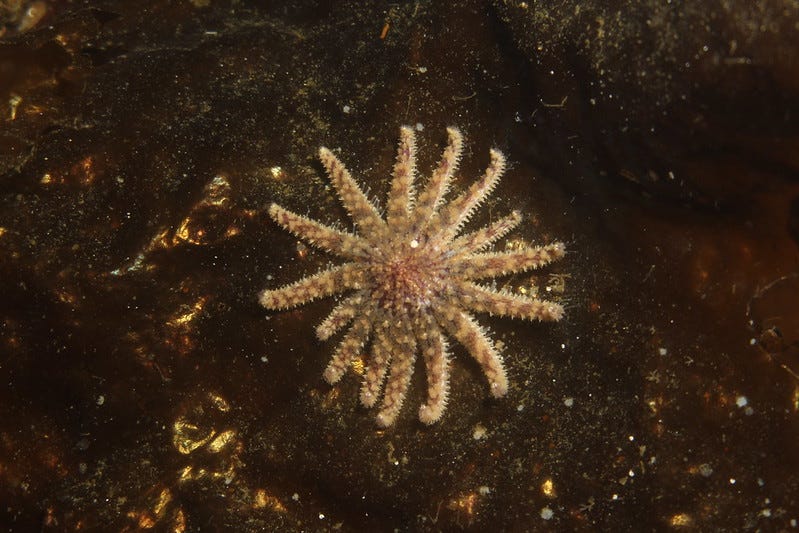Sunflower Sea Star Sightings Bring Hope to Mendocino Coast Kelp Restoration Efforts
The North Coast KelpFest continues Sunday
Correction 10/6/2025 12:07 p.m.: Pike Spector’s first name has been corrected.
Rachel Karm was diving in July, the day after her birthday, when she saw her first sunflower sea star.
“I moved a piece of algae to the side and I could see all of the arms,” she recalled.
Karm, a research technician at Sonoma State University who works on kelp restoration projects in Mendocino County, has been diving off the Mendocino Coast for the past five years. Seeing a sunflower sea star had always been in the back of her mind.
But it wasn’t until this year, while working on kelp restoration efforts funded by the National Oceanic and Atmospheric Administration (NOAA) as part of the Pacific Coast Ocean Restoration Initiative (PCOR), that she finally saw the marine animal in local waters. Sunflower sea stars are considered among the largest and fastest sea stars in the world.
“It was a really humbling moment and just thrilling seeing one of those in our restoration site,” she said. A month later, she spotted another. Recreational divers also reported two additional sightings this year.
The return of sunflower sea stars is one of several rays of hope being celebrated this weekend at the annual North Coast KelpFest in Fort Bragg. The festival—which features an art walk, parade, film screenings, urchin harvest, scientific lectures and project updates—aims to foster community appreciation and stewardship of kelp forests.
Tristin McHugh, kelp project director for The Nature Conservancy, describes kelp as “our coral reef,” calling it the equivalent of California’s Great Barrier Reef.
“Let’s start appreciating this very important vegetative community that supports the very air we breathe and the food that we eat,” she said.
Kelp forests are self-sustaining ecosystems, similar to terrestrial forests, providing shelter and nourishment to hundreds of marine species, including abalone, mussels and sea urchins, which also eat kelp itself. Sunflower sea stars prey on urchins, keeping the ecosystem in balance.
That balance was disrupted 12 years ago by a marine heatwave that weakened the kelp and exacerbated the spread of a pathogen causing sea star wasting syndrome. The disease decimated sea star populations and contributed to a 96% decline in bull kelp forests, with ripple effects throughout the marine food chain.
Sunflower sea stars are considered “functionally extinct,” according to David Sinn, a wildlife instructor at Cal Poly Humboldt who is working on an effort to reintroduce the animals.
Kelp forests are imperiled all along the California coast, but the situation in Mendocino County is particularly severe.
“Mendocino is the epicenter of the kelp catastrophe in California,” said Pike Spector, biodiversity program manager for the California Ocean Protection Council, speaking Friday at Fort Bragg Town Hall.
In response, federal and state agencies, along with private donors, have funded a surge of restoration work and innovative research, showcased this weekend at town hall exhibits.
Restoration efforts rely on a range of strategies. One of the most promising involves the physical removal of purple sea urchins, which have proliferated in the absence of their main predator, the sunflower sea star.
Researchers are also scaling up kelp reintroduction. At the Big River site, they deployed 50 kelp restoration units in late April.
In Del Norte County, restoration efforts are being tied to tribal stewardship. The Tolowa Dee-ni’ Nation, whose ancestral territory stretches from Wilson Creek near Klamath north to Port Orford, Oregon, is leading the “Kelp Guardians” project. The initiative focuses on building capacity and education, allowing the Nation to train and certify tribal members as scientific divers to monitor their ancestral waters.
“We didn’t really have the tools to do our own kelp research, so this project is providing that for us,” said Rosa Laucci, marine division manager and marine biologist for the Tolowa Dee-ni’ Nation. Laucci attended KelpFest Saturday.
The Tolowa Aboriginal Territory encompasses more than 100 miles of coastline and roughly 2.87 million acres of land, plus an undefined expanse of marine waters in Northern California and Southern Oregon. The Tolowa Dee-ni’ Nation is a founding member of the Tribal Marine Stewards Network, an alliance of California tribal nations working together to reclaim and revitalize stewardship of their ancestral ocean and coastal resources.



